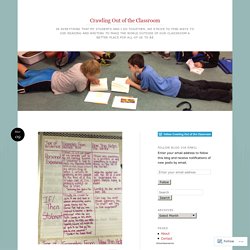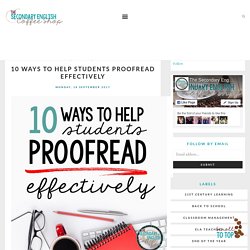

10 Teacher-Tested Strategies to Engage Reluctant Writers. A few years ago, my son opened a Google Document and started typing.

I asked him about it and his eyes lit up as he described the shared story he was writing with classmates. This was the first day of summer break but he was choosing to write for fun. It might not sound like much but it’s an example of the tiny miracles that happen in classrooms all the time. My son fell in love with writing in Ms. Reddiger’s class. Getting Out of the Essay Rut. Think about all the forms of writing that exist—letters, news articles, video scripts, infographics, press releases, etc. Why are we so hung up on using essays as the primary structure for students to demonstrate writing prowess? There can be little doubt, it seems to me, that we overuse essay writing in schools. And one result for our student writers is burnout. When the first-year teachers who I support explain to me that their kids are sick of writing essays—by February usually, if not sooner—we brainstorm together about alternatives they might consider.
These teachers will often report back that when they defected from the essay and assigned an alternative writing project for a particular lesson or unit, their students got excited and became inspired in ways the teachers hadn’t seen before. Amazon. Jeff Bezos Banned PowerPoint in Meetings. His Replacement Is Brilliant. In his 2018 annual letter, Amazon founder and CEO Jeff Bezos repeated his rule that PowerPoint is banned in executive meetings. What Bezos replaced it with provides even more valuable insight for entrepreneurs and leaders.
In his letter, and in a recent discussion at the Forum on Leadership at the Bush Center, Bezos revealed that "narrative structure" is more effective than PowerPoint. Supporting Claims With Evidence: Teaching Beyond the How. A few weeks ago, I wrote about the way that I frame our opinion writing work.

We begin our study of opinion writing by examining the many purposes for writing about our opinions and we look at how we can use writing in order to demand the change that we want to see in the world. (If you would like to read more about that work, you can find it in THIS BLOG POST.) Just like we spent time thinking about the different purposes for different types of opinion writing overall, I also wanted to engage my students in thinking about the different purposes for different types of evidence that they can use to support the reasons that they are making their claims through their writing. Opinion writing centers around evidence.
But too often, we tell our students to make sure that they support the claims that they are making with evidence without taking the time to look at the many different types of evidence that writers use in the world outside of school. And then. Rainbow Editing and Revising {FREEBIE!} 10 Ways to Help Students Proofread Effectively - The Secondary English Coffee Shop.
It’s human to occasionally write a typo or two, but what should an English teacher do when capable students make consistent, silly mistakes in their drafts?

Many students resist proofreading and editing at first because it means more “work”, and they’d rather just rely on spell check. Although it’s true that our students are busy and stretched thin, we teachers still have to defend the importance of taking that extra brief moment to proofread before printing or submitting. (Honestly, don’t most people need to think twice before they hit send?)
If your students’ mistakes are making you want to chuck your grading pen across the room in frustration (which I have done), check out this list of ideas. (P.S. - You might also like this sister post, 10 Ways to Teach Revision to Teens.)1. Don’t assume that students know the difference between finding errors, fixing errors, and changing content. 4. Writers Workshop Poster: How to Write a Good Essay Poster.
Today Show - WATCH: What's REALLY in a can of Libby's... Introducing The Writing Masters Blog Series. Writing is a complex, nuanced, and sometimes mystical journey.

Ideas take shape in ways we wouldn’t expect—and sometimes they struggle to take shape at all. As teachers, we strive to guide our students through this process—to encourage, support, and challenge them. Now imagine having master teachers mentor you along the way. Must know writing tips: How to kill off characters. While the topic of killing off characters may seem a bit strange, and truthfully, if taken outside of this particular context, yes, it would be, but when we’re talking about fictional writing, this is an important technique to know and understand.

As Jenna Moreci points out in the below video, let’s just be clear: this is fictional writing, nothing about this is real and we do not condone violence in any way in real life. Are we clear? Good. Teaching Writing to Tweens: Presence, Empathy, and Choice. By Patty McGee I write this article from the perspective of both an educator and the parent of a middle school student.

Perhaps some of you are nodding in understanding, speckled with a little empathy, about the ins and outs of working and living with middle graders, including that feeling of joy that comes with this unique, blossoming age. Right before our eyes we see: ► People who are unearthing their own, original identity. What Can I Work on As a Writer? Jennifer Serravallo, author of The Writing Strategies Book, has released a "Self-Reflection Tool for Finding Goals.

" In the resource, Jen explains why she created the tool and advises on five ways to utilize it: "I created this self-reflection tool to be used with students as you work to find and establish goals for each of them. I wanted to help you involve students in the goal-setting process by offering them the opportunity to identify with statements that align to different goals from the “Hierarchy of Writing Goals” in The Writing Strategies Book (Serravallo 2017, 3). What you’ll likely find in using this self-reflection tool is that some students are able to identify their strengths and needs with accuracy and ease, while others will need more guidance in reflecting on concrete work samples. You can download this free resource from Jen here and you can find a similar tool for The Reading Strategies Book here. Alternatives to the 5 Paragraph Essay. There are benefits to assigning a five-paragraph essay.

Its sturdy structure provides students with a safe and organized way to express their thoughts. The introduction enables them to stake a claim with the thesis. The body paragraphs are where they can make assertions and provide the supporting details to prove their argument. The conclusion wraps it all up, reinforcing the main ideas. Many students need that predictability. But the five-paragraph essay isn’t the be-all, end-all of student writing. How Do I Use The Writing Strategies Book with Other Writing Programs? The Writing Strategies Book, by Jennifer Serravallo, can be used effectively, with nearly any writing program or approach.

Its goals align well with many rubrics, scoring criteria, and assessment categories. To help you match your instruction with the strategies in her book, Jennifer has created a crosswalk to several commonly used writing approaches and programs. Those programs include: Se connecter à Facebook. Commoncraft. How to teach summary writing: the 1-hand summary. Se connecter à Facebook. Grades 6-8 Lessons: Real-World Writing. Text Puzzle Standard Met: CCSS.ELA-Literacy.W.6.5 What You Need: Copies of a short nonfiction text (such as a newspaper article), scissors, envelopes What to Do: Who doesn’t love a puzzle?

In this activity, students will piece together an article or nonfiction text that’s been pulled apart. To begin, prepare a text for each pair of students, cutting it into several chunks in places that break at the end of a sentence. Begin by discussing the importance of organizing a piece of writing. Students then work in pairs to put the text together. Farewell, Bad Habits! Standard Met: CCSS.ELA-Literacy.W.6.2.
Se connecter à Facebook. Thesis Statement Throwdown! Every English teacher has experienced the frustration of introducing a writing skill, like how to write a thesis statement, over and over again without it “sticking.” Three years ago, I began “flipping” my writing instruction, so students watch videos on my YouTube channel, take Cornell notes, then come prepared to class to do the actual writing. I love this approach to teaching writing! Students can watch my explanations as many times as they need to over the course of the year. Se connecter à Facebook. Se connecter à Facebook. Turkish Airlines Super Bowl Commercial 2018: Dr. Oz Ignites the Five Senses – Watch Now!
Se connecter à Facebook. Debate Boxing – A Way to Get Kids Thinking Fast. December is a fun month to teach if you know how to use the inevitable energy that the students bring in. While I may long for my fireplace and a good book, my students are eagerly awaiting snow, break, and perhaps even Christmas. To say that our classroom is loud in the afternoon is an understatement. Knowing the energy level of the kids, my smart colleague Reidun, therefore, proposed doing debate during the month of December, and boy was she right.
The energy is infectious, the kids are committed, and the engagement is high. While the students have successfully completed their practice unit, we are now gearing up for the big one; the summative debate where they must find their own articles, research reliability and also try to prep for whatever their opposing team will throw at them. Enter debate boxing. The concept is simple: Pick something for the students to debate. Se connecter à Facebook. Best Procedural Writing Mentor Texts, as Chosen by Teachers. If you teach “how to” or procedural writing, whether as a standalone unit or as one aspect of a study of informational writing, great mentor texts are gold. The right models can help take your students’ writing from “blah” to “wow.” Good trade book examples of this type of writing can be hard to find, so we hunted down these top choices to make your life easier: 1.
How to Be a Cat by Nikki McClure (Gr. K-1) KSPS Public TV - Pink for Boys and Blue for Girls might...